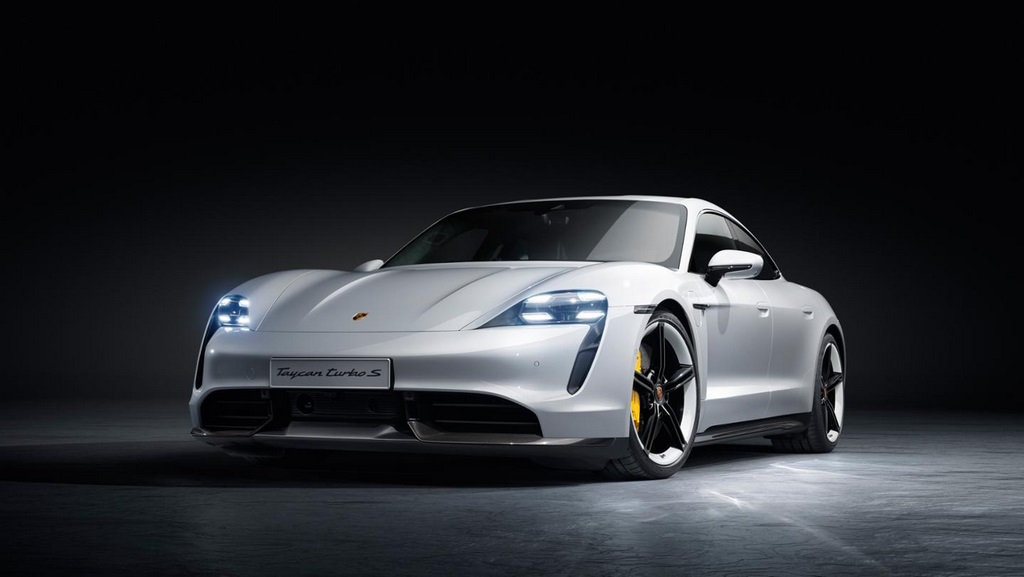Porsche has unveiled its maiden electric vehicle, the Taycan, in 2 variants – Turbo and Turbo S.

Tesla killers. We’ve heard the term before. Manufacturers like Faraday Future, Lucid Motors and Rivian threw everything they had on the wall to see what sticks and nothing really did. Most start-ups never even made it to production. Porsche’s new Taycan might just be the answer that the auto industry was looking for.
Porsche is offering the Taycan in two trims namely, Turbo and Turbo S. Before you wonder if this EV has a turbocharger, no. Porsche has stuck to its nomenclature hierarchy found in the petrol-powered models. Apart from these two, less powerful variants of the Taycan will be made available in the future.
The Taycan is distinctively a Porsche as the family DNA is lurking throughout the design. The design features a sporty roofline, the four-point design LED DRLs, pronounced shoulders, sculpted side section and the wide light bar at the rear which accentuates the width of the car. The aero vents below the headlamps might split opinions but the body-coloured insert at the rim on the Turbo S trim looks futuristic.
The Porsche Taycan EV is a 4-door electric sports car that resembles the Panamera in its proportions. It has a very low drag coefficient of 0.22, which makes the design aerodynamically efficient. This also contributes to lower energy consumption and a longer range. The Taycan measures 4963 mm in length, 1966 mm in width and has a 2900 mm long wheelbase. We expect the car to weigh around 2.2 tonnes.
Porsche has equipped the Taycan with an 800V architecture 93.4 KWh battery pack which is rated up to 270 KW. Charging time for a 270 KW charger is 22.5 minutes to 80% capacity, for a 150 KW charger is 36 minutes to 80% capacity and for a 9.6 KW 240V wall charger is 11 hours to 100% capacity. According to Porsche, the Taycan Turbo can cover a distance of 450 kms on a single charge and the Turbo S can cover 412 kms on a single charge.
Both the models feature a permanent synchronous motor. The Taycan Turbo can deliver up to 671 HP and 850 Nm of torque capable of clocking 0-60 mph (96 km/hr) in just 3.0 seconds, whereas the Taycan Turbo S can deliver upto 750 HP and 1050 Nm of torque capable of sprinting 0-60 mph (96 km/hr) in just 2.8 seconds. As for top speed, both the variants are electronically limited to 260 km/hr. Power is sent to the wheels with the help of a 2-speed transmission at the rear axle. First gear is said to be focused towards acceleration and the second gear towards efficiency.
The German automaker has poured a variety of innovations into the making of the Taycan. The interior of the Taycan is focused more towards the driver. There are up to 4 displays at the front – two at the centre console comprising the infotainment and the multipurpose controls, one at the instrumentation and another for the front passenger. The car has voice control and is initiated by the “Hey Porsche” command.
Porsche has a rich racing heritage, which is reflected in the dynamics of recent Porsche cars. They have years of fruitful experience in racing, vehicle dynamics and chassis control and its reflection can be seen in the plethora of electronics the Taycan comes with aiding the driver, push the car to its limits. The Taycan may not be quicker than a Tesla in a straight line but it will be way faster on a track.
Porsche Taycan EV
– Offered in 2 variants, Turbo and Turbo S
– Powered by a 93.4 KWh battery pack, the Taycan Turbo can cover up to 450 kms on a single charge
– The Turbo makes up to 671 HP and the Turbo S makes up to 750 HP




